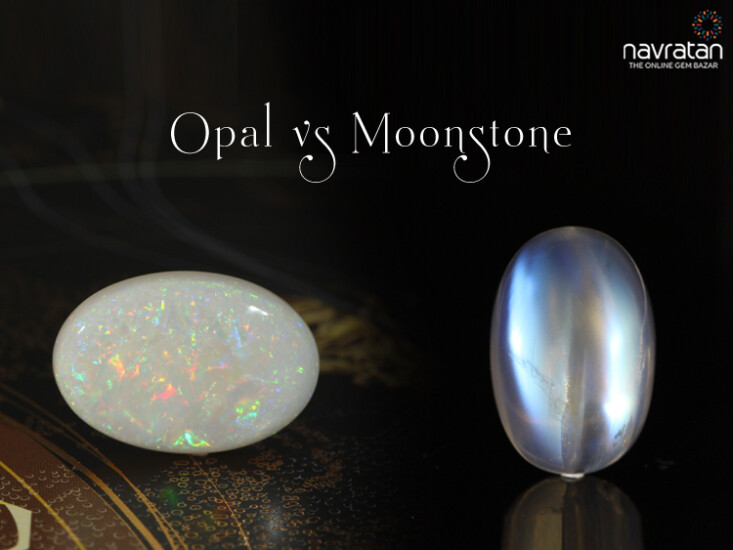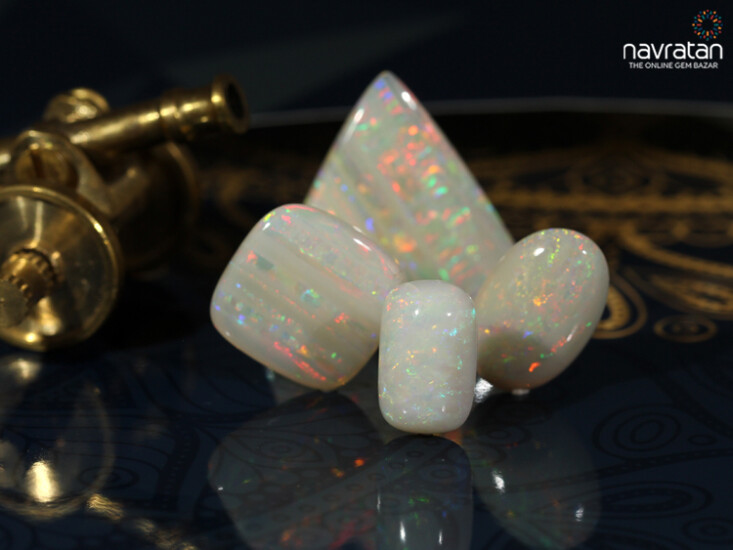 Categories
Categories 
Opals and moonstones are two of the most regaling, remarkable, and sought-after gemstones with astronomical significance and value. These two revered and scintillating gemstones look quite similar in appearance, but in reality, differ a lot in terms of physical property, color variation, value, and popularity.
Many people often search on web questions like “Are moonstones and opals the same?”, “What are the major differences between a moonstone and an opal?”, or how to differentiate between opals and moonstones in one go? To kick away all the clouds of confusion and enlighten our readers with every possible information and fact on moonstone and opal, we have carved an utterly informative and engulfing blog post that states the major difference between moonstone and opal stone on the basis of various parameters. With our meticulous comparative analysis, we will unveil a lot of information about these two gemstones that you weren’t aware of earlier.

Opal: The principal sources of the supreme quality opals are Ethiopia and Australia. However, Australia is considered accountable for more than 90% supply of pristine and stunning precious opals. Ethiopian opals are also hailed worldwide for their astonishing luster and golden hues but the deposit of opals is fettered to certain regions only. Apart from Australia and Ethiopia, Nevada province in the United States of America produces a multitude of black opals, fire opals, white opals, and lemon color opals.
Moonstone: If we talk about the origin of Moonstone, the deposits are found in numerous countries with Armenia, Australia, Madagascar, Poland, India, and the United States holding the major deposits of Moonstone. However, if we go by the statistics, the most remarkable and transparent moonstone with a startling blue sheen comes from Myanmar. In addition to that, Moonstones with the highest commercial value usually come from Sri Lanks in the current scenario.
Opal: Opal is one of the few gemstones in existence that comes in a plethora of colors with pink, blue, green, black, fire, and white colors are the prominent ones. Opal stone encloses a significant water percentage (as high as 25%) which plays a vital role in color change when the sunlight strikes the stone. Due to the diffraction phenomenon, the rays of light bend in water causing flickering of whimsical colors and making the stone look more alluring.

Moonstone: It is one of the few gemstones that exhibit adularescence, a rare phenomenon in which a soft blue sheen spreads over the inner surface of the stone which gives stones a divine look. In addition to that, moonstone also comes in a myriad of colors like grey, white, pink, and blue. The numerous layers of albite element are the principal reason behind the immense glitter of the moonstone.
Opal: When it comes to hardness, opal ranks slightly above the average mark as it has a hardness of 6.0 to 6.5 on the Mohs scale. That’s why one should take utmost care of opal stone while handling it because it’s more prone to damage. Opal has a sleek chemical composition of SiO2 and encloses a random atomic structure. It is also semi-translucent in nature.
Read More Pink Opal Healing Properties
Moonstone: Moonstone doesn’t differ from opal in terms of hardness as it also has a hardness of 6.0 to 6.5 on the Mohs scale, however, other physical properties vary vastly from opal. It’s a prominent variety of feldspar minerals with KAlSi3O8 chemical composition. Moonstone has a specific gravity of 2.58 along with a refractive index of 1.51 to 1.52.
Opal: Only a smidgen of natural opals are perfect in shape and utterly lustrous in appearance. Most opals undergo a variety of treatment methods like sugar treatment or smoke treatment to amplify their appearance by leaps and bounds and become market ready. Though heat-related treatments are less preferred, they are still used to make the stone more marketable.
Moonstone: As moonstones are alluring and glittering in appearance and in coveted shapes as well, they undergo minimal to no treatments. In addition to that, only the most dexterous stone cutters are hired to give a to T orientation to the moonstones as they are not much durable by nature. In a moonstone, the flat plane is found first and used a principal basis for the further cutting of the stone.
Opal: Opal is a stone with heaps of physical, astrological, and spiritual significance. It is one of the rare gemstones that offer maximum benefits and minimal negative effects to the wearer. It provides emotional stability as well as an utterly positive outlook toward life to the wearer. Moreover, embracing opal also protects your mindset and ensures your energy is utilized in the right direction. Opal also provides immense financial success and acknowledgment to the wearer along with carving a charismatic personality.
Read More Types of Opal
Moonstone: Moonstone is massively regarded for its miraculous effects on the physical and mental health of the wearer. Women who struggle with dire stress and anxiety all the time can benefit greatly by embracing moonstones. This stone can also sharpen your intuition skills and help you find out clairvoyant abilities. This stone is also renowned for its dazzling healing properties as it can treat a multitude of physical ailments in no time

Opal: There is no denying that opal topples moonstone by miles when it comes to value or price. Fire Opal is way more exorbitant than moonstone as well as high in demand in the global market. The most affordable type of opals is boulder opals. The lush white shades of opals are the most revered and valued ones and the price for them can go as high as $1000 per carat. The cut as well as the carat weight of the stone are also significant factors in determining the price and value.
Read More Astrological Benefits of Opal
Moonstone: Moonstone spree of advantages ends on this pointer as it is less valuable than opal, however, the top-notch quality moonstones can be priced as high as $2000 per carat and topple the average quality opals in terms of price. Moonstones can be preserved for a long time if handled with utmost care and keeping all precautions in mind. Moreover, moonstone jewelry pieces are way more popular and groovy than opal jewelry because moonstones are more alluring in appearance.
Opal: As opal encapsulates around 25% water by weight, one has to take extra care and give undivided attention to the maintenance of this revered stone. If you don’t take good care of opal, you will find a lot of cracks on the surface of the stone with the passage of time. Moreover, Opal is average in terms of hardness, therefore, stone, as well as opal jewelry, must be kept in a velvet pouch or a velvet box to avoid any scratches or damage.
If opal stone loses its color, it’s recommended to put it in distilled water for a few days so that it can regain its color and luster back and look pristine again
Moonstone: Though moonstones require less maintenance and care than opals, it is strictly advised to not keep them under sunlight for a long time as they can lose their striking luster. Moreover, you should also avoid exposure to chemicals in your moonstone or its jewelry if you want to preserve its brilliant luster for a long time.
It is also recommended to avoid using hot water and a brush to clean moonstones as using them causes a loss in luster as well as numerous scratches on the surface. Not many people know that Moonstone exemplifies the planet moon and it can be energized to reap the maximum benefits by placing it under the full moonlight. Once it is energized completely, it will definitely pass on all the benefits to the wearer.